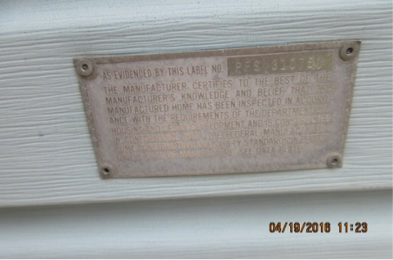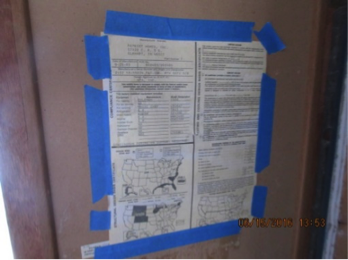- Home
- 4 Point Inspection
- Wind Mitigation Inspection
- WDO - Termite Inspection
- Blogs
- Home Inspection Authorization
- Qualifications
- Inspection Areas
- News
- 15 Tools Every Homeowner Should Own
- Chinese Drywall
- Infrared - Thermal Imagery
- License
- Manufactured Home Certification/Tie Down Certification
- Polybutylene
- Standards of Practice
- 10 Easy Ways To Save Energy
Manufactured Home Certification/Tie Down Certification
Through registered field inspectors throughout the country we provide:
- Permanent Foundation Certifications of Manufactured Homes.
- Certification of additions to Manufactured Homes (decks, porches, rooms).
- Expedient Service with Professional Reports.
If you are a Realtor, Lender, Buyer or Seller in need of a HUD Foundation Certification or Addition Certification, click here to find your local inspector.
* Certifications provided by Patrick Conroy, P.E. in MI (PE-46918), NC (PE-046168), SC (PE-35200), VT (018-134582), and PA (PE071011)
FAQ
Is it a Modular, Mobile or Manufactured Home?
MODULAR
A modular home is like a stick-built home but is done so in sections and in a factory setting (controlled environment). The sections are then transported and assembled on the building site. Modular homes cannot be moved once built and they are built on permanent foundation walls of either masonry block, poured concrete or wood. Modular homes are built in compliance with typical building codes just as a stick-built home would be.
MOBILE
Mobile homes are the predecessor of manufactured homes but built prior to 1976 prior to the HUD Standards being published. These were generally poorly built and not to either Federal or local standards/codes.
MANUFACTURED
Manufactured Homes are built from 1976 and on when the HUD standards became effective. The HUD standards improved the quality, safety, and energy efficiency of the homes. The most recent HUD standards are dated September 1996.
A manufactured home (formerly known as a mobile home) is built to the Manufactured Home Construction and Safety Standards (HUD Code) and displays a red certification label on the exterior of each transportable section. Manufactured homes are built in the controlled environment of a manufacturing plant and are transported in one or more sections on a permanent chassis.
Manufactured homes have exterior certification labels and an interior data plate where Mobile and Modular homes do not.

2: Example of a HUD Certification Label

3: Example of a HUD Data Plate
What if My Home was Built Prior to 1976?
Homes built prior to June 15, 1976, even with modifications, do not meet the HUD standards and cannot be accepted as compliant with the HUD Code. FHA does not insure mortgages on manufactured homes built prior to June 15, 1976. Most other mortgage insurance firms follow FHA's policy.
What are HUD Guidelines?
The current HUD Permanent Foundation Guide for Manufactured housing is dated September of 1996. The guidelines specify many things in regards to the construction of Manufactured Homes. Manufactured Home Construction and Safety Standards mandate federal standards for design, construction, and installation of manufactured homes to assure the quality, durability, safety, and affordability of manufactured homes.
Nature of Program: HUD issues and enforces appropriate standards for the construction, design, performance, and installation of manufactured homes to assure their quality, durability, affordability, and safety. The construction and safety standards preempt state and local laws that are not identical to the federal standards; they apply to all manufactured homes produced after June 15, 1976. HUD may enforce these standards directly or by various states that have established state administrative agencies in order to participate in the program. HUD may inspect factories and retailer lots and review records to enforce such standards. If a manufactured home does not conform to federal standards, the manufacturer must take certain actions, including possibly notifying the consumer and correcting the problem.
The statute generally prohibits selling, leasing, or offering for sale or lease, homes that do not meet the standards. Civil and criminal penalties may be sought for violations of the statute.
HUD also administers programs regulating the installation of the homes, reviewing the installation standard programs that 35 states have, and administering a federal installation program in the other 15 states. HUD also reviews the administration of state dispute resolution programs in 35 states and administers a HUD dispute resolution program in the other 15 states.
What is A HUD Permanent Foundation Inspection?
A HUD engineering foundation inspection is:
To conduct a structural inspection for determining:
- If the manufactured home is permanently tied down, and
- That the home would not float off the piers or foundation,
- That the drainage of the house will not flood the crawlspace or basement.
What about Engineering Inspections of Additions?
Decks, porches and room additions are regulated by the construction codes for each state and/or local housing authority. If the property has an addition attached after the home was sited, the attachment is not regulated by HUD Standards or Regulations. If an addition has been added to a manufactured home, it may take the home out of conformance with the Standards.
How long does it take to get an Engineering Inspection Report?
That is dependent upon the inspector you hire. Generally, inspections and reports are turned around in 2 to 3 days.
How Much Does an Inspection Cost?
There are two different inspections. The main one is the Permanent Foundation Inspection and the other is for additions, decks, porches, alterations. Your lender will know which of the inspections you will need done.
Bookmark/Search this post with


